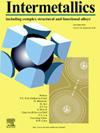机械合金化fesb基合金的非晶化和能量图
IF 4.3
2区 材料科学
Q2 CHEMISTRY, PHYSICAL
引用次数: 0
摘要
在本研究中,研究了不同的机械合金化工艺参数,如球粉重量比(BPR)、磨球尺寸、转速和磨球时间对铁(Fe)、硅(Si)和硼(B)元素共混物非晶化的影响。以硬脂酸为过程控制剂(PCA),将元素粉末机械合金化10、20和30 h,转速为700 rpm,球粉比为5:1、10:1和15:1,得到FeSiB粉末合金。然后使用火花等离子烧结(SPS)技术对所得粉末进行固结。研究了SPS工艺参数对材料力学性能和磁性能的影响。在相同条件下,烧结温度越高,试样的饱和磁化强度越高。此外,还研究了SPS加工前对非晶粉末合金进行热处理的效果。结果表明,热处理后样品的饱和磁化强度有所增加,矫顽力也有所增加。最后,绘制了在不同条件下铣削的机械合金fesb基样品的能量图,以找到单个球的总能量和最小能量的窗口,从而得到有助于磁性能的非晶结构。本文章由计算机程序翻译,如有差异,请以英文原文为准。
Amorphization and energy maps of mechanically alloyed FeSiB-based alloys
In this research work, the effect of different mechanical alloying processing parameters such as ball-to-powder weight ratio (BPR), size of the milling balls, rotation speed, and milling duration on the amorphization of an elemental blend of iron (Fe), silicon (Si), and boron (B) have been studied. FeSiB powder alloys were obtained by mechanically alloying of elemental powders for 10, 20, and 30 h with a rotation speed of 700 rpm, stearic acid as process control agent (PCA), and the ball-to-powder ratio of 5:1, 10:1, and 15:1. The resultant powders were then consolidated using the spark plasma sintering (SPS) technique. The effect of SPS processing parameters on mechanical and magnetic properties was studied. For samples milled under the same conditions, the saturation magnetization of the samples sintered at higher temperatures was proven to be higher. Moreover, the effect of heat treating the amorphous powder alloy before SPS processing was studied. The results showed an increase in the saturation magnetization of the heat-treated samples but also an increase in coercivity. Finally, the energy maps were drawn for mechanically alloyed FeSiB-based samples milled under different conditions to find the window for the total energy and minimum energy of a single ball that would give us an amorphous structure useful for magnetic properties.
求助全文
通过发布文献求助,成功后即可免费获取论文全文。
去求助
来源期刊

Intermetallics
工程技术-材料科学:综合
CiteScore
7.80
自引率
9.10%
发文量
291
审稿时长
37 days
期刊介绍:
This journal is a platform for publishing innovative research and overviews for advancing our understanding of the structure, property, and functionality of complex metallic alloys, including intermetallics, metallic glasses, and high entropy alloys.
The journal reports the science and engineering of metallic materials in the following aspects:
Theories and experiments which address the relationship between property and structure in all length scales.
Physical modeling and numerical simulations which provide a comprehensive understanding of experimental observations.
Stimulated methodologies to characterize the structure and chemistry of materials that correlate the properties.
Technological applications resulting from the understanding of property-structure relationship in materials.
Novel and cutting-edge results warranting rapid communication.
The journal also publishes special issues on selected topics and overviews by invitation only.
 求助内容:
求助内容: 应助结果提醒方式:
应助结果提醒方式:


